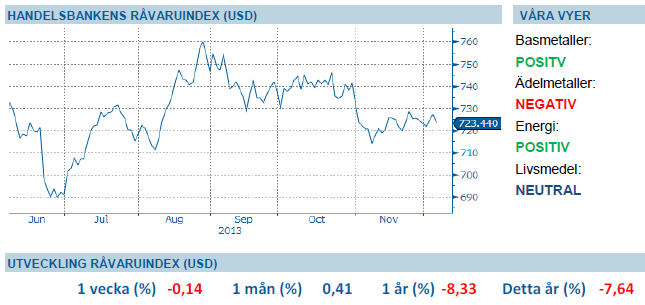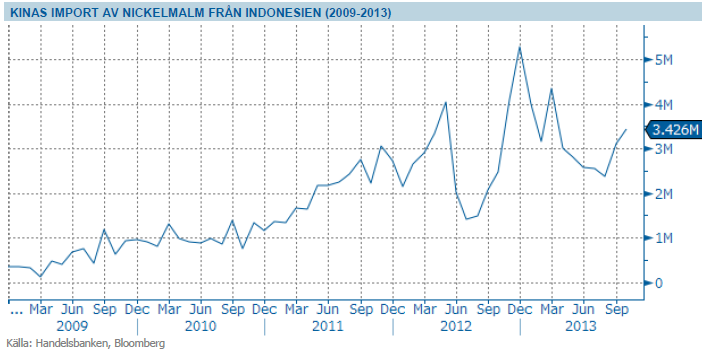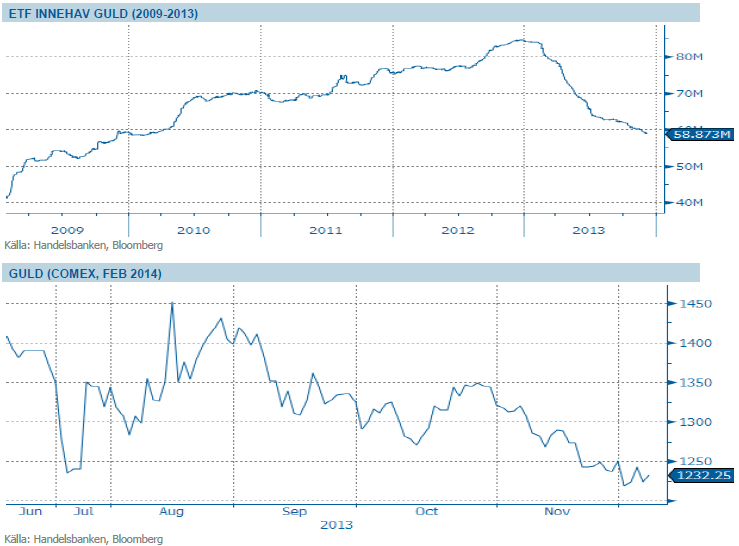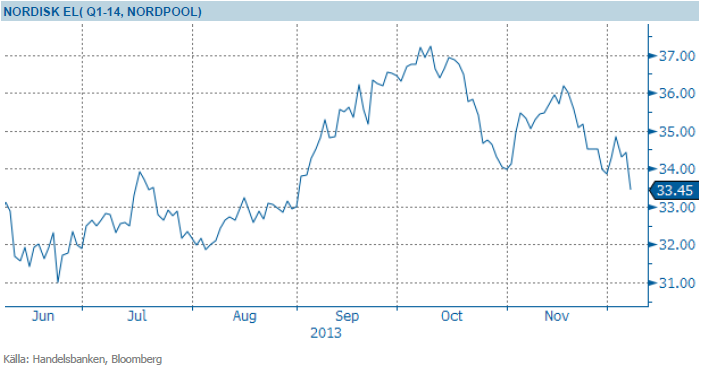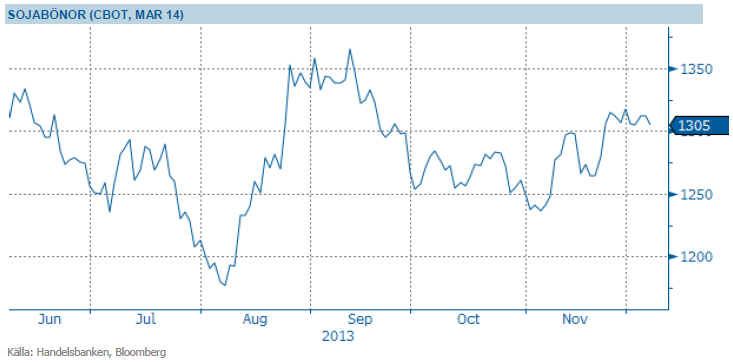Analys
SHB Råvarubrevet 6 december 2013

 Råvaror allmänt
Råvaror allmänt
Råvaror gynnas av makroklimatet
För råvaror är det generella makroklimatet gott. Vi ser ett starkt momentum i Kina, centralbanker världen över fortsätter vara superrelaxade och den generella konjunkturåterhämtningen fortsätter varför 2014 kommer bli ett bättre år för världsekonomin än 2013. Trots detta ser vi ingen stark trend uppåt bland råvarorna. Investerare har blivit mer försiktiga när man diskonterar Kinas lägre tillväxt framgent. Den tillväxt som finns blir också allt mindre tiltad mot infrastrukturella investeringar. I det korta perspektivet ser vi att lagercykeln bottnar ur och ska efterföljas av en påfyllnad med ökad import av råvaror som konsekvens.
I närtid finns mer ljus. Oljemarknaden har ett säsongsmässigt starkt kvartal framför sig drivet av bland annat norra halvklotets vinter. Vi har listat utsikterna för guld och silver och det enda argumentet för uppgång i närtid är skuldtaksdiskussionen i USA i januari. Tyngst vägande på nedsidan ser vi den stundande nedskalningen av QE vara. Den amerikanska konjunkturen fortsätter att förbättras och med det tilltar Taper-oron. Framför allt starkare arbetsmarknadsdata ökar sannolikheten för att Fed rör sig i närtid.
Positiv data fortsätter under fredagseftermiddag. USA:s non-farm payrolls visade på fler sysselsatta än väntat. 203 000 fler i november mot förväntat 185 000.
Basmetaller
Indonesiens exportförbud åter i fokus
Priset på samtliga basmetaller har stigit under veckan, vårt basmetallindex är stiger med 1,1 %. Stark jobbdata från USA har stärkt metallerna men även Indonesiens exportförbud har stått i fokus och givit stöd. Potentialen för nickel under 2014 är till del beroende av Indonesiens planerade exportförbud. För den som inte är insatt i problematiken har Kina under senare år kraftigt ökat sin import av lågkvalitativ nickelmalm från främst Indonesien. Kina utvinner sedan själva nickeln ur malmen, med stora negativa miljöeffekter. Detta har gjort att priset på nickel fallit kraftigt på världsmarknaden. Indonesien vill nu få en större del av förädlingsvärdet själva och har därför beslutat om ett exportförbud på nickelmalm från och med årsskiftet 2013/14.
Detta har gjort att Kina importerat ännu mer nickelmalm i år för att lägga på lager, och importerat mindre nickel. Nickelpriset har även påverkats negativt av den svaga ekonomiska utvecklingen i Europa och av den pågående diskussionen om att Kina ställer om från investerings- till konsumtionsledd tillväxt. Om Indonesiens exportstopp träder i kraft som planerat, kommer Kinas lager av nickelmalm successivt att betas av och därefter bedömer vi att priserna på nickel kommer att börja stiga igen, eftersom Kina måste börja importera. Den exakta tidpunkten för detta är dock svår att fastslå. Dessutom finns en risk att Indonesien i sista stund ställer in exportförbudet, på grund av politiska påtryckningar. Sannolikheten för detta är ännu svårare att bestämma. Vår grundsyn är dock att nickelpriset bör återhämta sig under loppet av 2014, om världskonjunkturen fortsätter att förbättras och Indonesien inför exportförbud.
Exportförbudet ger även stöd till aluminium och kopparpriset då bauxit och kopparmalm även innefattas av förbudet.
Vi tror att Kinas tillväxt kommer överraska positivt under Q4 och Q1, vilket kommer stärka metallerna. Vi tror på: LONG BASMETALLER H
Ädelmetaller
Guldet fortsätter sin väg nedför
Guldet har visserligen haft en del rörelser under veckan men stänger veckan på minus återigen. Och utflödet ur guld ETF:er fortsätter. Vi hade under förra veckan hela nordens gruv- och metallindustrihöjdare i Stockholm, och har kunnat lyssna in på deras syn på marknaden för 2014. Det som stack ut när det gäller guld är att just denna metall toppat investerares intresse att placera gruvrelaterat riskkapital under 2012. Vår syn är att denna sorts investeringar görs både med eftersläpning och i flockbeteende. 2013 års prisfall på guld gör att vår gissning är att guldet inte kommer toppa tabellerna när årets investeringar summeras. Detta torde tala för ett minskat utbud av nyproducerat fysiskt guld framöver, vilket teoretiskt torde peka på att priset kan bottna ur.
Men som vi skrivit om tidigare, världen kommer inte att drabbas av plötslig guldbrist, allt guld som utvunnits i historien finns fortfarande kvar i lager. Lager för guld är ju bankvalv, bankfack eller smyckeskrin. Efter våra kontakter i veckan blev det också tydligt att branschen inte är inställd på att priset ska kunna komma ner till tresiffriga nivåer. Då hela vår erfarenhet från andra marknader lärt oss att just marknader tenderar att vara riktigt elaka tror vi att 1000 dollar per uns kommer att testas.
Efter en uppgång under sommaren tror vi åter att guldets väg lutar utför. Vi tror på: SHRT GULD H
Energi
OPEC möte i fokus
Brent noteras närmare 2 månaders högsta efter positiv statistik från de två ledande oljekonsumenterna USA och Kina. Intressant att även notera investerarstatistiken där nettolånga positioner på Brent ökat med 43 procent de senaste två veckorna. Fokus har under veckan annars varit på OPEC mötet i Wien där Saudi´s oljeminister signalerade att ”the oil market is in the best situation it can be and that the current price level is the right price”. Det går att tolka som att OPEC sannolikt inte kommer att göra så mycket mer just nu men men sannolikt kommer att agera i takt med att Libyen´s samt övriga löser sina utbudsstörningar. Brent och WTI spreaden krymper efter nyheten om att TransCanada´s pipeline (700,000bpd) ser ut att komma igång vilket kommer att minska lagren vid Cushing. Läs även veckans tradingcase på olja här.
Elmarknaden som öppnade upp under inledningen av veckan försvagas mot slutet (Q1-14 når nytt all time low) och det är främst väderprognoserna som tynger sentimentet. Ett vått (ca 3TWh nederbörd över normalt) och milt (1-2 grader över normalt) scenario för hela den kommande 10-dagars perioden innebär att energiunderskottet fortsätter at minska i rask takt mot normalnivåer om det här håller i sig.
Inga större förändringar på vare sig kol som finner stöd strax över 80 USD/ton eller utsläppsrätter vilket med USD/EUR utvecklingen innebär att brytpriset ligger kvar oförändrat den senaste månaden. Med prognosen som ligger bör kvartalskontrakten kunna falla ytterligare någon EUR men vi bedömer att fallhöjden sedan är begränsad om vi går mot normalväder igen.
Konjunkturen för 2014 ser ut att bli starkare än 2013 för samtliga regioner i världen, och konsumtionen av olja minskar inte trots ett starkt driv mot förnyelsebara energikällor. Vi tror på: LONG OLJA H
Livsmedel
Höga sojaskördar väntas i Sydamerika
Priset på sojabönor faller med någon procent under veckan i linje med våra förväntningar. Mest i fokus nu är väderutvecklingen i Sydamerika, vilken än så länge varit gynnsam. Den brasilianska sådden går mot sitt slut och gynnsamt regn har fallit. I Argentina uppges 58 procent av sådden vara avklarad. Om inga väderproblem uppstår i Sydamerika tror vi på lägre priser framöver – just för tillfället får dock priserna stöd av en ganska god efterfrågan, som vanligt inte minst från Kina.
Majs har handlats upp nästan 2 % under veckan. Mer regn har fallit i de norra delarna av Argentina, vilket är klart gynnsamt för redan sådd gröda och gynnar även pågående sådd. I landets södra delar önskas fortfarande dock mer regn. 48 % av sådden uppges vara avklarad, att jämföra med 58% vid samma tid förra året. Sista delen av skörden i EU går så sakteliga framåt i stundtals regn stundtals snö, dock återstår nu endast en liten del. Liknande situation råder i Ukraina. Utan mer väderproblem i Sydamerika är det för tillfället svårt att se varför majspriserna skulle börja stiga då tillgången på majs globalt är väldigt god.
Efter flera år av rekordskördar handlas kaffe idag på femårslägsta. Vi finner kaffe köpvärd och ser risken på nedsidan begränsad. Vi tror på: LONG KAFFE H
Handelsbankens Råvaruindex
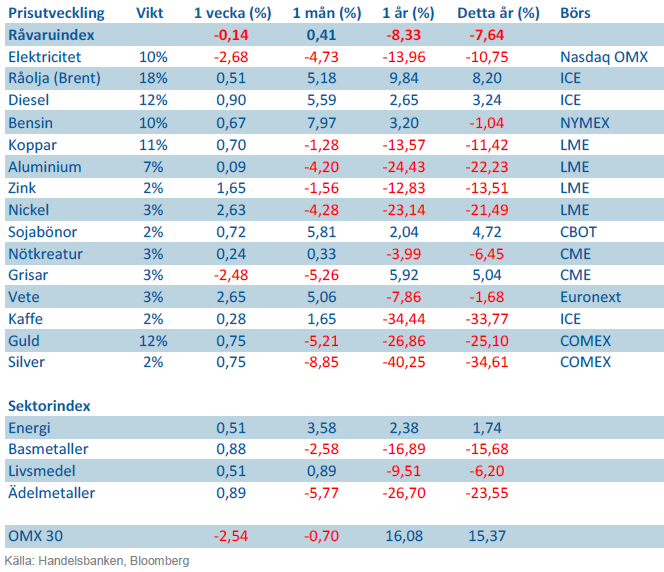
*Nya vikter från den 29 november 2013.
Handelsbankens råvaruindex består av de underliggande indexen för respektive råvara. Vikterna är bestämda till hälften från värdet av nordisk produktion (globala produktionen för sektorindex) och till hälften från likviditeten i terminskontrakten.
[box]SHB Råvarubrevet är producerat av Handelsbanken och publiceras i samarbete och med tillstånd på Råvarumarknaden.se[/box]
Ansvarsbegränsning
Detta material är producerat av Svenska Handelsbanken AB (publ) i fortsättningen kallad Handelsbanken. De som arbetar med innehållet är inte analytiker och materialet är inte oberoende investeringsanalys. Innehållet är uteslutande avsett för kunder i Sverige. Syftet är att ge en allmän information till Handelsbankens kunder och utgör inte ett personligt investeringsråd eller en personlig rekommendation. Informationen ska inte ensamt utgöra underlag för investeringsbeslut. Kunder bör inhämta råd från sina rådgivare och basera sina investeringsbeslut utifrån egen erfarenhet.
Informationen i materialet kan ändras och också avvika från de åsikter som uttrycks i oberoende investeringsanalyser från Handelsbanken. Informationen grundar sig på allmänt tillgänglig information och är hämtad från källor som bedöms som tillförlitliga, men riktigheten kan inte garanteras och informationen kan vara ofullständig eller nedkortad. Ingen del av förslaget får reproduceras eller distribueras till någon annan person utan att Handelsbanken dessförinnan lämnat sitt skriftliga medgivande. Handelsbanken ansvarar inte för att materialet används på ett sätt som strider mot förbudet mot vidarebefordran eller offentliggörs i strid med bankens regler.
Analys
Tightening fundamentals – bullish inventories from DOE

The latest weekly report from the US DOE showed a substantial drawdown across key petroleum categories, adding more upside potential to the fundamental picture.

Commercial crude inventories (excl. SPR) fell by 5.8 million barrels, bringing total inventories down to 415.1 million barrels. Now sitting 11% below the five-year seasonal norm and placed in the lowest 2015-2022 range (see picture below).
Product inventories also tightened further last week. Gasoline inventories declined by 2.1 million barrels, with reductions seen in both finished gasoline and blending components. Current gasoline levels are about 3% below the five-year average for this time of year.
Among products, the most notable move came in diesel, where inventories dropped by almost 4.1 million barrels, deepening the deficit to around 20% below seasonal norms – continuing to underscore the persistent supply tightness in diesel markets.
The only area of inventory growth was in propane/propylene, which posted a significant 5.1-million-barrel build and now stands 9% above the five-year average.
Total commercial petroleum inventories (crude plus refined products) declined by 4.2 million barrels on the week, reinforcing the overall tightening of US crude and products.


Analys
Bombs to ”ceasefire” in hours – Brent below $70

A classic case of “buy the rumor, sell the news” played out in oil markets, as Brent crude has dropped sharply – down nearly USD 10 per barrel since yesterday evening – following Iran’s retaliatory strike on a U.S. air base in Qatar. The immediate reaction was: “That was it?” The strike followed a carefully calibrated, non-escalatory playbook, avoiding direct threats to energy infrastructure or disruption of shipping through the Strait of Hormuz – thus calming worst-case fears.

After Monday morning’s sharp spike to USD 81.4 per barrel, triggered by the U.S. bombing of Iranian nuclear facilities, oil prices drifted sideways in anticipation of a potential Iranian response. That response came with advance warning and caused limited physical damage. Early this morning, both the U.S. President and Iranian state media announced a ceasefire, effectively placing a lid on the immediate conflict risk – at least for now.
As a result, Brent crude has now fallen by a total of USD 12 from Monday’s peak, currently trading around USD 69 per barrel.
Looking beyond geopolitics, the market will now shift its focus to the upcoming OPEC+ meeting in early July. Saudi Arabia’s decision to increase output earlier this year – despite falling prices – has drawn renewed attention considering recent developments. Some suggest this was a response to U.S. pressure to offset potential Iranian supply losses.
However, consensus is that the move was driven more by internal OPEC+ dynamics. After years of curbing production to support prices, Riyadh had grown frustrated with quota-busting by several members (notably Kazakhstan). With Saudi Arabia cutting up to 2 million barrels per day – roughly 2% of global supply – returns were diminishing, and the risk of losing market share was rising. The production increase is widely seen as an effort to reassert leadership and restore discipline within the group.
That said, the FT recently stated that, the Saudis remain wary of past missteps. In 2018, Riyadh ramped up output at Trump’s request ahead of Iran sanctions, only to see prices collapse when the U.S. granted broad waivers – triggering oversupply. Officials have reportedly made it clear they don’t intend to repeat that mistake.
The recent visit by President Trump to Saudi Arabia, which included agreements on AI, defense, and nuclear cooperation, suggests a broader strategic alignment. This has fueled speculation about a quiet “pump-for-politics” deal behind recent production moves.
Looking ahead, oil prices have now retraced the entire rally sparked by the June 13 Israel–Iran escalation. This retreat provides more political and policy space for both the U.S. and Saudi Arabia. Specifically, it makes it easier for Riyadh to scale back its three recent production hikes of 411,000 barrels each, potentially returning to more moderate increases of 137,000 barrels for August and September.
In short: with no major loss of Iranian supply to the market, OPEC+ – led by Saudi Arabia – no longer needs to compensate for a disruption that hasn’t materialized, especially not to please the U.S. at the cost of its own market strategy. As the Saudis themselves have signaled, they are unlikely to repeat previous mistakes.
Conclusion: With Brent now in the high USD 60s, buying oil looks fundamentally justified. The geopolitical premium has deflated, but tensions between Israel and Iran remain unresolved – and the risk of missteps and renewed escalation still lingers. In fact, even this morning, reports have emerged of renewed missile fire despite the declared “truce.” The path forward may be calmer – but it is far from stable.
Analys
A muted price reaction. Market looks relaxed, but it is still on edge waiting for what Iran will do

Brent crossed the 80-line this morning but quickly fell back assigning limited probability for Iran choosing to close the Strait of Hormuz. Brent traded in a range of USD 70.56 – 79.04/b last week as the market fluctuated between ”Iran wants a deal” and ”US is about to attack Iran”. At the end of the week though, Donald Trump managed to convince markets (and probably also Iran) that he would make a decision within two weeks. I.e. no imminent attack. Previously when when he has talked about ”making a decision within two weeks” he has often ended up doing nothing in the end. The oil market relaxed as a result and the week ended at USD 77.01/b which is just USD 6/b above the year to date average of USD 71/b.

Brent jumped to USD 81.4/b this morning, the highest since mid-January, but then quickly fell back to a current price of USD 78.2/b which is only up 1.5% versus the close on Friday. As such the market is pricing a fairly low probability that Iran will actually close the Strait of Hormuz. Probably because it will hurt Iranian oil exports as well as the global oil market.
It was however all smoke and mirrors. Deception. The US attacked Iran on Saturday. The attack involved 125 warplanes, submarines and surface warships and 14 bunker buster bombs were dropped on Iranian nuclear sites including Fordow, Natanz and Isfahan. In response the Iranian Parliament voted in support of closing the Strait of Hormuz where some 17 mb of crude and products is transported to the global market every day plus significant volumes of LNG. This is however merely an advise to the Supreme leader Ayatollah Ali Khamenei and the Supreme National Security Council which sits with the final and actual decision.
No supply of oil is lost yet. It is about the risk of Iran closing the Strait of Hormuz or not. So far not a single drop of oil supply has been lost to the global market. The price at the moment is all about the assessed risk of loss of supply. Will Iran choose to choke of the Strait of Hormuz or not? That is the big question. It would be painful for US consumers, for Donald Trump’s voter base, for the global economy but also for Iran and its population which relies on oil exports and income from selling oil out of that Strait as well. As such it is not a no-brainer choice for Iran to close the Strait for oil exports. And looking at the il price this morning it is clear that the oil market doesn’t assign a very high probability of it happening. It is however probably well within the capability of Iran to close the Strait off with rockets, mines, air-drones and possibly sea-drones. Just look at how Ukraine has been able to control and damage the Russian Black Sea fleet.
What to do about the highly enriched uranium which has gone missing? While the US and Israel can celebrate their destruction of Iranian nuclear facilities they are also scratching their heads over what to do with the lost Iranian nuclear material. Iran had 408 kg of highly enriched uranium (IAEA). Almost weapons grade. Enough for some 10 nuclear warheads. It seems to have been transported out of Fordow before the attack this weekend.
The market is still on edge. USD 80-something/b seems sensible while we wait. The oil market reaction to this weekend’s events is very muted so far. The market is still on edge awaiting what Iran will do. Because Iran will do something. But what and when? An oil price of 80-something seems like a sensible level until something do happen.
-

 Nyheter4 veckor sedan
Nyheter4 veckor sedanUppgången i oljepriset planade ut under helgen
-

 Nyheter3 veckor sedan
Nyheter3 veckor sedanMahvie Minerals växlar spår – satsar fullt ut på guld
-

 Nyheter4 veckor sedan
Nyheter4 veckor sedanLåga elpriser i sommar – men mellersta Sverige får en ökning
-

 Nyheter2 veckor sedan
Nyheter2 veckor sedanOljan, guldet och marknadens oroande tystnad
-

 Analys4 veckor sedan
Analys4 veckor sedanVery relaxed at USD 75/b. Risk barometer will likely fluctuate to higher levels with Brent into the 80ies or higher coming 2-3 weeks
-

 Nyheter2 veckor sedan
Nyheter2 veckor sedanJonas Lindvall är tillbaka med ett nytt oljebolag, Perthro, som ska börsnoteras
-

 Analys3 veckor sedan
Analys3 veckor sedanA muted price reaction. Market looks relaxed, but it is still on edge waiting for what Iran will do
-

 Nyheter2 veckor sedan
Nyheter2 veckor sedanDomstolen ger klartecken till Lappland Guldprospektering


